Nakshatra
Nakshatra (Sanskrit: नक्षत्र, IAST: Nakṣatra) is the term for lunar mansion in Hindu astrology. A nakshatra is one of 28 (sometimes also 27) sectors along the ecliptic. Their names are related to the most prominent asterisms in the respective sectors.
The starting point for the nakshatras according to Vedas is "Krittika" but usually it is the point on the ecliptic directly opposite to the star Spica called Chitrā in Sanskrit (other slightly different definitions exist). It is called Meshādi or the "start of Aries". The ecliptic is divided into each of the nakshatras eastwards starting from this point. The number of nakshatras reflects the number of days in a sidereal month (modern value: 27.32 days), the width of a nakshatra traversed by the Moon in about one day. Each nakshatra is further subdivided into four quarters (or padas). These play a role in popular Hindu astrology, where each pada is associated with a syllable, conventionally chosen as the first syllable of the given name of a child born when the Moon was in the corresponding pada.
The nakshatras of traditional bhartiya astronomy are based on a list of 28 asterisms found in the Atharvaveda (AVŚ 19.7) and also in the Shatapatha Brahmana. The first astronomical text that lists them is the Vedanga Jyotisha.
In classical Hindu scriptures (Mahabharata, Harivamsa), the creation of the nakshatras is attributed to Daksha. They are personified as daughters of the deity and as wives of Chandra, the Moon god, or alternatively the daughters of Kashyapa, the brother of Daksha.
Each of the nakshatras is governed as 'lord' by one of the nine graha in the following sequence: Ketu (South Lunar Node), Shukra (Venus), Surya (Sun), Chandra (Moon), Mangala (Mars), Rahu (North Lunar Node), Brihaspati (Jupiter), Shani (Saturn) and Budha (Mercury). This cycle repeats itself three times to cover all 27 nakshatras. The lord of each nakshatra determines the planetary period known as the dasha, which is considered of major importance in forecasting the life path of the individual in Hindu astrology.
In Vedic Sanskrit, the term nákṣatra may refer to any heavenly body, or to "the stars" collectively. The classical concept of a "lunar mansion" is first found in the Atharvaveda, and becomes the primary meaning of the term in Classical Sanskrit.
Nakshatras in the Atharvaveda
In the Atharvaveda (Shaunakiya recension, hymn 19.7) a list of 28 stars or asterisms is given, many of them corresponding to the later nakshatras:[1]
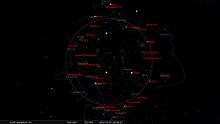
Interestingly enough, the term "nakshatra" has a different meaning as demonstrated in the "Surya Siddhanta", which is an ancient text on astronomy. In the early chapters, the author, Mayasura or Mayan, describes various time units. He writes that a "prana" is a duration of 4 seconds. He then continues with a discussion of a number of time units with progressively long durations made up of the shorter time units all composed of a number of pranas. Amongst those time units are something he calls "nakshatra". For example: 15 pranas are in a minute; 900 pranas in an hour; 21600 pranas in a day; 583,200 pranas in a nakshatra (month). According to Mayan, a nakshatra is a time unit with a duration of 27 days.[2]
This 27-day time cycle has been taken to mean a particular group of stars. The relationship to the stars really has to do with the periodicity with which the Moon travels over time and through space past the field of the specific stars called nakshatras. Hence, the stars are more like numbers on a clock through which the hands of time pass (the moon). This concept was discovered by Dr. Jessie Mercay in her research on Surya Siddhanta.[3]
List of Nakshatras
The classical list of 27 nakshatras is first found in the Vedanga Jyotisha, a text dated to the 600-700 BCE. The nakshatra system predates the Hellenistic astronomy which became prevalent from about the 2nd century CE.
In Hindu astronomy, there was an older tradition of 28 Nakshatras which were used as celestial markers in the heavens. When these were mapped into equal divisions of the ecliptic, a division of 27 portions was adopted since that resulted in a cleaner definition of each portion (i.e. segment) subtending 13° 20' (as opposed to 12° 51 3/7’ in the case of 28 segments). In the process, the Nakshatra Abhijit was left out without a portion.[4]:179 The Surya Siddhantha concisely specifies the coordinates of the twenty seven Nakshatras[4]:211
The following list of nakshatras gives the corresponding regions of sky, following Basham.[5]
| No. | Name | Associated stars | Description | Image |
|---|---|---|---|---|
| 1 | Ashwini |
β and γ Arietis |
|
 |
| 2 | Bharani "the bearer" |
35, 39, and 41 Arietis |
|
 |
| 3 | Krittika an old name of the Pleiades; personified as the nurses of Kārttikeya, a son of Shiva. |
Pleiades |  | |
| 4 | Rohini "the red one", a name of Aldebaran. Also known as brāhmī |
Aldebaran |
|
 |
| 5 | Mrigashīra "the deer's head". Also known as āgrahāyaṇī |
λ, φ Orionis |  | |
| 6 | Ardra "the moist one" |
Betelgeuse |
|
 |
| 7 | Punarvasu (dual) "the two restorers of goods", also known as yamakau "the two chariots" |
Castor and Pollux |
|
 |
| 8 | Pushya/Tishya "the nourisher", also known as sidhya or tiṣya |
γ, δ and θ Cancri |  | |
| 9 | Ashleshā "the embrace" |
δ, ε, η, ρ, and σ Hydrae |
|
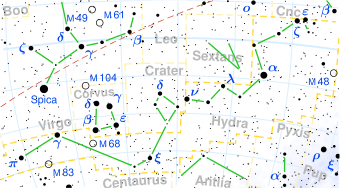 |
| 10 | Maghā "the bountiful" |
Regulus |
|
 |
| 11 | Pūrva Phalgunī "first reddish one" |
δ and θ Leonis |
|
 |
| 12 | Uttara Phalgunī "second reddish one" |
Denebola |
|
 |
| 13 | Hasta "the hand" |
α, β, γ, δ and ε Corvi |
|
 |
| 14 | Chitra "the bright one", a name of Spica |
Spica |
|
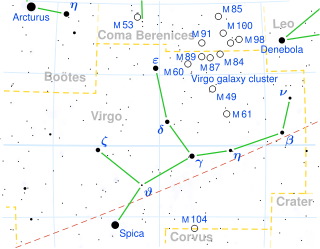 |
| 15 | Swāti "Su-Ati (sanskrit) Very good" name of Arcturus |
Arcturus |
|
 |
| 16 | Visakha "forked, having branches"; also known as rādhā "the gift" |
α, β, γ and ι Librae | 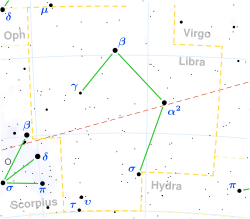 | |
| 17 | Anuradha "following rādhā" |
β, δ and π Scorpionis |
|
 |
| 18 | Jyeshtha "the eldest, most excellent" |
α, σ, and τ Scorpionis |
|
 |
| 19 | Mula "the root" |
ε, ζ, η, θ, ι, κ, λ, μ and ν Scorpionis |
|
 |
| 20 | Purva Ashadha "first of the aṣāḍhā", aṣāḍhā "the invincible one" being the name of a constellation |
δ and ε Sagittarii |
|
 |
| 21 | Uttara Ashadha "second of the aṣāḍhā" |
ζ and σ Sagittarii |
|
 |
| 22 | Abhijit "victorious"[6] |
α, ε and ζ Lyrae - Vega | Astrological Mate: Brahma
|
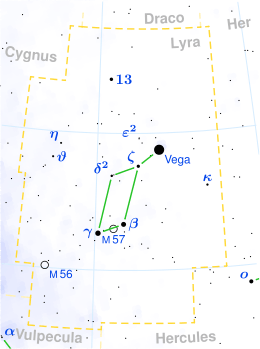 |
| 23 | Shravana |
α, β and γ Aquilae |
|
 |
| 24 | Dhanishta "most famous", also Shravishthā "swiftest" |
α to δ Delphini |
|
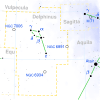 |
| 25 | Shatabhisha "Comprising a hundred physicians" |
γ Aquarii |
|
 |
| 26 | Purva Bhadrapada "the first of the blessed feet" |
α and β Pegasi |
|
 |
| 27 | Uttara Bhadrapada "the second of the blessed feet" |
γ Pegasi and α Andromedae |
|
.png) |
| 28 | Revati "prosperous" |
ζ Piscium |
|
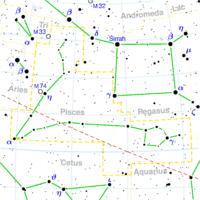 |
Padas (quarters)
Each of the 27 Nakshatras cover 13°20’ of the ecliptic each. Each Nakshatra is also divided into quarters or padas of 3°20’, and the below table lists the appropriate starting sound to name the child. The 27 nakshatras, each with 4 padas, give 108, which is the number of beads in a japa mala, indicating all the elements (ansh) of Vishnu:
| # | Name | Pada 1 | Pada 2 | Pada 3 | Pada 4 | Vimsottari Lord | Ruling Deity |
|---|---|---|---|---|---|---|---|
| 1 | Aśvini (अश्विनि) | चु Chu | चे Che | चो Cho | ला La | Ketu | Aswini Kumara |
| 2 | Bharaṇī (भरणी) | ली Li | लू Lu | ले Le | लो Lo | Venus | Yama |
| 3 | Kṛttikā (कृत्तिका) | अ A | ई I | उ U | ए E | Sun | Agni |
| 4 | Rohiṇī (रोहिणी) | ओ O | वा Va/Ba | वी Vi/Bi | वु Vu/Bu | Moon | Brahma |
| 5 | Mṛgaśīrṣā(म्रृगशीर्षा) | वे Ve/Be | वो Vo/Bo | का Ka | की Ke | Mars | Moon |
| 6 | Ārdrā (आर्द्रा) | कु Ku | घ Gha | ङ Ng/Na | छ Chha | Rahu | Shiva |
| 7 | Punarvasu (पुनर्वसु) | के Ke | को Ko | हा Ha | ही Hi | Jupiter | Aditi |
| 8 | Puṣya (पुष्य) | हु Hu | हे He | हो Ho | ड Da | Saturn | Jupiter |
| 9 | Āśleṣā (आश्लेषा) | डी Di | डू Du | डे De | डो Do | Mercury | Rahu |
| 10 | Maghā (मघा) | मा Ma | मी Mi | मू Mu | मे Me | Ketu | Sun |
| 11 | Pūrva or Pūrva Phālgunī (पूर्व फाल्गुनी) | नो Mo | टा Ta | टी Ti | टू Tu | Venus | Aryaman |
| 12 | Uttara or Uttara Phālgunī (उत्तर फाल्गुनी) | टे Te | टो To | पा Pa | पी Pi | Sun | Sun |
| 13 | Hasta (हस्त) | पू Pu | ष Sha | ण Na | ठ Tha | Moon | Viswakarma |
| 14 | Chitrā (चित्रा) | पे Pe | पो Po | रा Ra | री Ri | Mars | Vaayu |
| 15 | Svāti (स्वाति) | रू Ru | रे Re | रो Ro | ता Ta | Rahu | Indra |
| 16 | Viśākhā (विशाखा) | ती Ti | तू Tu | ते Te | तो To | Jupiter | Mars |
| 17 | Anurādhā (अनुराधा) | ना Na | नी Ni | नू Nu | ने Ne | Saturn | Indra |
| 18 | Jyeṣṭhā (ज्येष्ठा) | नो No | या Ya | यी Yi | यू Yu | Mercury | Nirriti |
| 19 | Mūla (मूल) | ये Ye | यो Yo | भा Bha | भी Bhi | Ketu | Varuna |
| 20 | Pūrva Aṣāḍhā (पूर्वाषाढ़ा) | भू Bhu | धा Dha | फा Bha/Pha | ढा Dha | Venus | Viswadeva |
| 21 | Uttara Aṣāḍhā (उत्तराषाढ़ा) | भे Bhe | भो Bho | जा Ja | जी Ji | Sun | Brahma |
| 22 | Śrāvaṇa (श्रावण) | खी Ju/Khi | खू Je/Khu | खे Jo/Khe | खो Gha/Kho | Moon | Vishnu |
| 23 | Śrāviṣṭhā (श्रविष्ठा) or Dhaniṣṭhā (धनिष्ठा) | गा Ga | गी Gi | गु Gu | गे Ge | Mars | Vasu |
| 24 | Śatabhiṣā (शतभिषा)or Śatataraka | गो Go | सा Sa | सी Si | सू Su | Rahu | Varuna |
| 25 | Pūrva Bhādrapadā (पूर्वभाद्रपदा) | से Se | सो So | दा Da | दी Di | Jupiter | Ajacharana |
| 26 | Uttara Bhādrapadā (उत्तरभाद्रपदा) | दू Du | थ Tha | झ Jha | ञ Da/Tra | Saturn | Ahirbudhanya |
| 27 | Revati (रेवती) | दे De | दो Do | च Cha | ची Chi | Mercury | Pooshan |
Hindu given names
Hindu astrologers (see Jyotisha) teach that when a child is born, they should be given an auspicious first name which will correspond to the child's Nakshatra. The technique for deducing the name is to see which nakshatra the Moon is in at the moment of birth; this gives four possible sounds. A refinement is to pick one sound out of that four that relates to the Pada or division of the Nakshatra. Each Nakshatra has four Padas and four sounds and each Pada is of equal width. The Moon remains in each Nakshatra for approximately one day.
A further refinement or opportunity is to instead use the Nakshatra that the ascendent resides in at birth. The same broad choice of sounds and Padas apply, but now the sounds change roughly every 15 minutes. The ascendent passes through all 27 Nakshatras every 24 hours, being in each one for 53 and a third minutes of time, and is in a Pada for 13 and a third minutes of time. By using the ascendent's nakshatra, instead of the Moon's nakshatra leads more to comfort of the Self, rather than comfort of the mother. This second approach is only really applicable if intuitively the Moon approach does not feel right.
Electional astrology
Constellations are grouped on the basis of their nature, type of their face, degree of their beneficence, their quarters in different signs, with reference to the constellation occupied by the Sun, with reference to the birth constellation (Janma Nakshatra), their caste, etc. The current constellation occupied by the Moon, and its nature forms the fundamental of Vedic system of electional astrology (Muhurta). Some of the activities and works which are associated with the Nakshatras are given below based on their fundamental nature:
- Fixed (Dhruva, Sthira) constellations:
Rohini, Uttara Bhādrapadā, Uttra Falguni, and Uttara Ashada
Fixed and permanent nature, house, village, temple, entering in new hose-city-temple, religious works, rites for getting peace, propitiation of portents, Vinayaka Shanti, coronation, sowing of seeds, planting of small garden, starting of vocal music, friendship, sexual works, making & wearing of ornaments & clothes may be auspiciously begun / effectively performed. Works allocated to delicate & friendly (Mridu) asterisms may also be performed.
- Movable (Chala , Chara) constellations:
Punarvasu, Swaati, Sharavana, Shatabhishā & Shravishthā
Related to motion & movement, riding on a vehicle or elephant, opening of shop, walking first time, walking in garden, sex, making jewellery, learning of a trait. Things performed in Small (Laghu) constellation are also effectively performed in the Movable constellations.
- Cruel (Ugra, Karur) constellations:
Magha, Bharani, Porva Palguni, Poorva Shada, & Poorva Bhadra.
Ambush, burning, poisoning (self & others), making & using weapons especially related to fire, cheating / deception / wickedness / craftiness, cutting & destroying, controlling of animals, beating & punishing of enemy. Works allocated to Sharp / Horrible (Darun) asterisms are also successfully done in these asterisms.
- Mixed (Mishra & Sadharan) constellations
Vishakha & Krittika.
Fire works, burning of sacred fire (Agnihotra), using poison, fearsome works, arresting, adulteration (mixing), donation of ox to get one’s desires fulfilled (Vrashotsarga). Works prescribed under cruel (Ugra, Karur) constellations may also be performed. As per N.S. works of Sweet / delicate & friendly (Mridu & Maitri) constellations can also be included.
- Small (Laghu & Kshipra) constellations
Hasta, Abhijit, Pushya, and Ashvini.
Selling, medical knowledge, using & handling of medicines, literature-music-art, the 64 Kala Shilpa (various arts, sculpture etc.) jewellery making & wearing, sexual intercourse. And the works prescribed for Movable (Char) constellations. Though Abhijit is included in Small group of asterisms, but is rarely referred in the Muhurt prescriptions.
- Sweet/Delicate & Friendly (Mridu & Maitri) constellations
Mrigashīrsha, Chitra, Anuradha and Revati.
Starting & learning singing of songs, clothes & jewellery making & wearing, Manglik works, matter related to friends, female company, enjoyments, sexual passions.
- Sharp & Horrible ( Teekshan & Darun ) constellations:
Jyeshta, Ardra, Ashlesha, and Moola
Charm or spell causing disease or death, hypnotism, sorcery; ghost, ambush, horror, murder, capture, matters related to secrecy, backbiting, starting of quarrel, separation, matters related to friendship & breaking thereof, training & tying of animals, pleasure works, playing games, getting made & wearing of new dress & ornaments, starting & learning singing of songs, entering into village / city, peaceful & developmental works.
Names in modern languages
The names of nakshatras in other languages are adapted from the Sanskrit variation (apabhramsa) through Pali or Prakrit. The variations evolved for easier pronunciation in popular usage.
| # | Sanskrit | Bengali name নক্ষত্র | Malayalam name മലയാളം | Tamil name தமிழ் | Telugu name తెలుగు | Kannada name ಕನ್ನಡ | Western star name |
|---|---|---|---|---|---|---|---|
| 1 | Aśvinī अश्विनी | Aśvinī অশ্বিনী | Ashvati അശ്വതി | Aswini அஸ்வினி | Aśvinī అశ్విని | Aśvinī ಅಶ್ವಿನಿ | β and γ Arietis |
| 2 | Bharaṇī भरणी | Bharaṇī ভরণী | Bharaṇi ഭരണി | Baraṇi பரணி | Bharaṇi భరణి | Bharaṇi ಭರಣಿ | 35, 39, and 41 Arietis |
| 3 | Kṛttikā कृत्तिका | Kṛttikā কৃত্তিকা | Kārttika കാർത്തിക | Kārthikai கார்த்திகை | Kṛttika కృత్తిక | Kruthike ಕೃತಿಕೆ | Pleiades |
| 4 | Rohiṇī रोहिणी | Rohiṇī রোহিণী | Rōhiṇi രോഹിണി | Rōhiṇi ரோகிணி | Rōhiṇi రోహిణి | Rōhiṇi ರೋಹಿಣಿ | Aldebaran |
| 5 | Mṛgaśiras म्रृगशीर्षा | Mṛgaśiras মৃগশিরা | Makayiram മകയിരം | Mirugasīridam மிருகசீரிடம் | Mṛgaśira మృగశిర | Mṛgaśira ಮೃಗಶಿರ | λ, φ Orionis |
| 6 | Ārdrā आद्रा | Ārdrā আর্দ্রা | Ātira or Tiruvātira ആതിര (തിരുവാതിര) | Thiruvādhirai திருவாதிரை | Arudra ఆరుద్ర | Aridra ಆರಿದ್ರ | Betelgeuse |
| 7 | Punarvasu पुनर्वसु | Punarvasu পুনর্বসু | Puṇartam പുണർതം | Punarpoosam புனர்பூசம் | Punarvasu పునర్వసు | Punarvasu ಪುನರ್ವಸು | Castor and Pollux |
| 8 | Puṣya पुष्य | Puṣya পুষ্যা (তিষ্যা) | Pūyam പൂയം | Poosam பூசம் | Puṣyami పుష్యమి | Puṣya ಪುಷ್ಯ | γ, δ and θ Cancri |
| 9 | Aśleṣā आश्ळेषा / आश्लेषा | Aśleṣā অশ্লেষা | Āyilyam ആയില്യം | Ayilyam ஆயில்யம் | Aśleṣa ఆశ్లేష | Aśleṣa ಆಶ್ಲೇಷ | δ, ε, η, ρ, and σ Hydrae |
| 10 | Maghā मघा | Maghā মঘা | Makam മകം | Magam மகம் | Makha or Magha మఖ or మాఘ | Makha ಮಖ | Regulus |
| 11 | Pūrva or Pūrva Phalguṇī पूर्व फाल्गुनी | Pūrva or Pūrva Phalguṇī পূর্ব ফল্গুনী | Pūram പൂരം | Pooram பூரம் | Pūrva Phalguṇī or Pubba పూర్వా ఫల్గుణి or పుబ్బ | Pubba ಪುಬ್ಬ, ಪೂರ್ವ-ಫಲ್ಗುಣಿ | δ and θ Leonis |
| 12 | Uttara or Uttara Phalguṇī उत्तर फाल्गुनी | Uttara or Uttara Phalguṇī উত্তর ফল্গুনী | Utram ഉത്രം | Uthiram உத்திரம் | Uttara Phalguṇi or Uttara ఉత్తర ఫల్గుణి or ఉత్తర | Utthara ಉತ್ತರ, ಉತ್ತರ-ಫಲ್ಗುಣಿ | Denebola |
| 13 | Hasta हस्त | Hasta হস্তা | Attam അത്തം | Astham அஸ்தம் | Hasta హస్త | Hasta ಹಸ್ತ | α, β, γ, δ and ε Corvi |
| 14 | Citrā चित्रा | Citrā চিত্রা | Chittira (Chitra) ചിത്തിര (ചിത്ര) | Chithirai சித்திரை | Cittā or Citrā చిత్తా or చిత్రా | Citta ಚಿತ್ತ | Spica |
| 15 | Svāti स्वाति | Svāti স্বাতী | Chōti ചോതി | Swathi சுவாதி | Svāti స్వాతి | Svāti ಸ್ವಾತಿ | Arcturus |
| 16 | Viśākha विशाखा | Viśākha বিশাখা | Vishākham വിശാഖം | Visakam விசாகம் | Viśākha విశాఖ | Viśākhe ವಿಶಾಖೆ | α, β, γ and ι Librae |
| 17 | Anurādhā अनुराधा | Anurādhā অনুরাধা | Anizham അനിഴം | Anusham அனுஷம் | Anurādhā అనూరాధ | Anurādhā ಅನುರಾಧ | β, δ and π Scorpionis |
| 18 | Jyeṣṭha ज्येष्ठा | Jyeṣṭha জ্যেষ্ঠা | Kēṭṭa (Trikkēṭṭa) കേട്ട (തൃക്കേട്ട) | Kettai கேட்டை | Jyeṣṭha జ్యేష్ఠ | Jyeṣṭha ಜ್ಯೇಷ್ಠ | α, σ, and τ Scorpionis |
| 19 | Mūla मूल/मूळ | Mūla মূলা | Mūlam മൂലം | Mūlam மூலம் | Mūla మూల | Mūla ಮೂಲ | ε, ζ, η, θ, ι, κ, λ, μ and ν Scorpionis |
| 20 | Pūrvāṣāḍha पूर्वाषाढा | Pūrvāṣāḍha পূর্বাষাঢ়া | Pūrāṭam പൂരാടം | Pūradam பூராடம் | Pūrvāṣāḍha పూర్వాషాఢ | Pūrvāṣāḍha ಪೂರ್ವಾಷಾಢ | δ and ε Sagittarii |
| 21 | Uttarāṣāḍha उत्तराषाढा | Uttarāṣāḍha উত্তরাষাঢ়া | Utrāṭam ഉത്രാടം | Uthirādam உத்திராடம் | Uttarāṣāḍha ఉత్తరాషాఢ | Uttarāṣāḍha ಉತ್ತರಾಷಾಢ | ζ and σ Sagittarii |
| 22 | Śravaṇa श्रवण | Śravaṇa শ্রবণা | Tiruvōnam ഓണം (തിരുവോണം) | Tiruvōnam திருவோணம் | Śravaṇaṁ శ్రవణం | Śravaṇa ಶ್ರವಣ | α, β and γ Aquilae |
| 23 | Śraviṣṭhā or Dhaniṣhṭha श्रविष्ठा or धनिष्ठा | Śraviṣṭhā or Dhaniṣṭha ধনিষ্ঠা (শ্রবিষ্ঠা) | Aviṭṭam അവിട്ടം | Aviṭṭam அவிட்டம் | Dhaniṣhṭha ధనిష్ఠ | Dhaniṣṭha ಧನಿಷ್ಠ | α to δ Delphinus |
| 24 | Śatabhiṣak or Śatatārakā शतभिषक् / शततारका | Śatabhiṣak or Śatatārakā শতভিষা | Chatayam ചതയം | Sadayam சதயம் | Śatabhiṣaṁ శతభిషం | Śatabhiṣa ಶತಭಿಷ | γ Aquarii |
| 25 | Pūrva Bhādrapadā पूर्वभाद्रपदा / पूर्वप्रोष्ठपदा | Pūrva Bhādrapadā পূর্ব ভাদ্রপদ | Pūruruṭṭāti പൂരുരുട്ടാതി | Pūraṭṭādhi பூரட்டாதி | Pūrvābhādra పూర్వాభాద్ర | Pūrvābhādra ಪೂರ್ವಾ ಭಾದ್ರ | α and β Pegasi |
| 26 | Uttara Bhādrapadā उत्तरभाद्रपदा / उत्तरप्रोष्ठपदा | Uttara Bhādrapadā উত্তর ভাদ্রপদ | Uttṛṭṭāti ഉത്രട്ടാതി | Uttṛṭṭādhi உத்திரட்டாதி | Uttarābhādra ఉత్తరాభాద్ర | Uttarābhādra ಉತ್ತರಾ ಭಾದ್ರ | γ Pegasi and α Andromedae |
| 27 | Revatī रेवती | Revatī রেবতী | Rēvati രേവതി | Rēvathi ரேவதி | Rēvati రేవతి | Rēvati ರೇವತಿ | ζ Piscium |
See also
- Atmakaraka
- Navagraha
- Panchangam
- Gandanta
- Chinese constellation
- Twenty-eight mansions
- Decans (Egyptian)
References
- ↑ trans. Ralph T. H. Griffith, Hymns of the Atharva Veda, 1895[].
Original text via GRETIL from Gli inni dell’ Atharvaveda (Saunaka), trasliterazione a cura di Chatia Orlandi, Pisa 1991, collated with the ed. R. Roth and W.D. Whitney: Atharva Veda Sanhita, Berlin 1856.
- citrā́ṇi sākáṃ diví rocanā́ni sarīsr̥pā́ṇi bhúvane javā́ni | turmíśaṃ sumatím ichámāno áhāni gīrbhíḥ saparyāmi nā́kam
- suhávam agne kŕ̥ttikā róhiṇī cā́stu bhadráṃ mr̥gáśiraḥ śám ārdrā́ | púnarvasū sūnŕ̥tā cā́ru púṣyo bhānúr āśleṣā́ áyanaṃ maghā́ me
- púṇyaṃ pū́rvā phálgunyau cā́tra hástaś citrā́ śivā́ svātí sukhó me astu | rā́dhe viśā́khe suhávānurādhā́ jyéṣṭhā sunákṣatram áriṣṭa mū́lam
- ánnaṃ pū́rvā rāsatāṃ me aṣādhā́ ū́rjaṃ devy úttarā ā́ vahantu | abhijín me rāsatāṃ púṇyam evá śrávaṇaḥ śráviṣṭhāḥ kurvatāṃ supuṣṭím
- ā́ me mahác chatábhiṣag várīya ā́ me dvayā́ próṣṭhapadā suśárma | ā́ revátī cāśvayújau bhágaṃ ma ā́ me rayíṃ bháraṇya ā́ vahantu
- ↑ Mayasura or Mayan (date unknown). "Surya Siddhanta". Ancient text on astronomy.
- ↑ Mercay, Jessie (2012). "Fundamentals of Mamuni Mayans Vaastu Shastras, Building Architecture of Sthapatya Veda and Traditional Indian architecture." Mercay, 2006 - 2012, AUM Science and Technology publishers.
- 1 2 Burgess, Ebenezer (1858). Translation of the Surya Siddhantha, a Textbook of Hindu Astronomy. The American Oriental Society.
- ↑ Arthur Llewellyn Basham, Indian Astronomy Appendix: Astronomy.
- ↑ ||ζ and σ Lyra Its longitude starts from 06° 40' to 10° 53' 40 in sidereal Capricorn i.e. from the last quarter of Uttra Ashadha to first 1/15 th part of Shravana. Its span is 4° 13' 40. The span of 27 mean daily lunar motions totals 355.76167 degrees, and together these total 359.98945 degrees. Considered an "intercalary" lunar mansion.